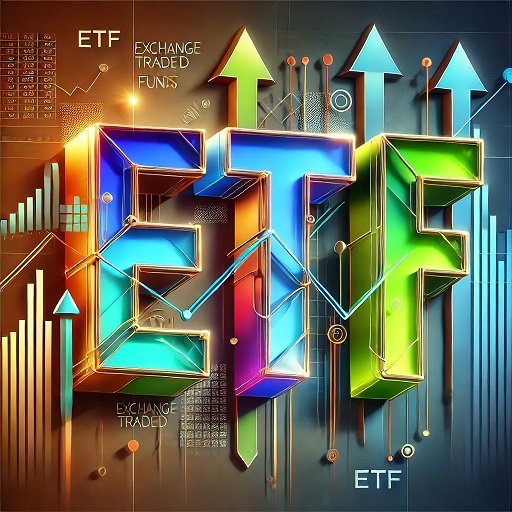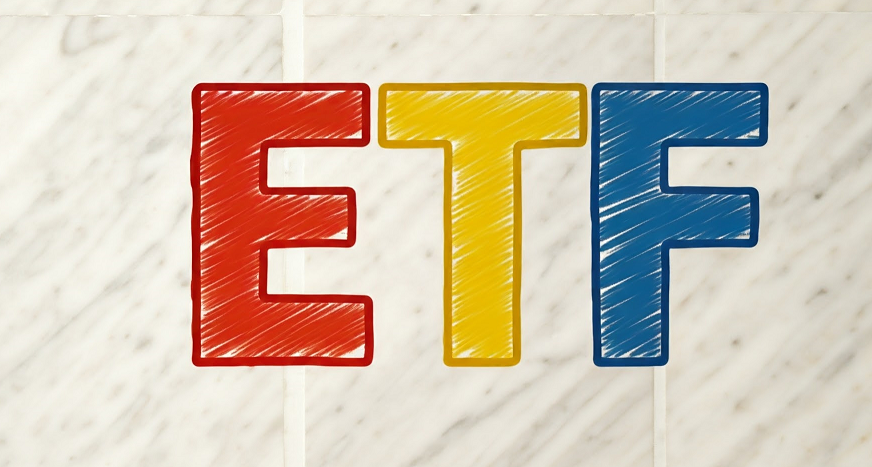In today’s dynamic financial markets, sector ETFs have emerged as powerful tools for investors seeking to capitalize on industry-specific opportunities while managing risk through diversification. The SPDR Select Sector ETFs,offered by State Street Global Advisors, provide investors with targeted exposure to the 11 GICS sectors of the S&P 500, each suited to distinct market conditions.
These specialized funds track indexes composed of companies within particular sectors such as technology, healthcare, finance, energy, and consumer goods. Unlike broad-market ETFs, sector ETFs allow investors to express viewpoints on specific industries and implement tactical asset allocation strategies. This article explores all 11 sectors and their ideal economic environments.
Technology (XLK)
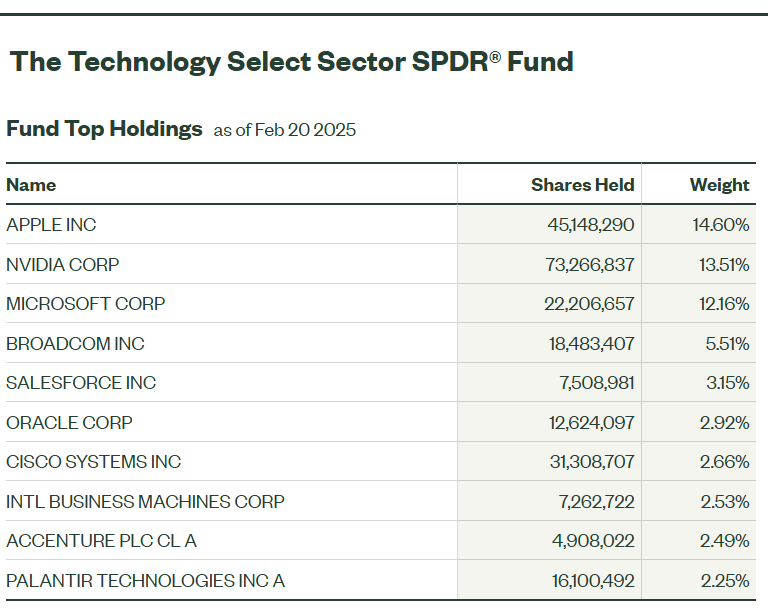
Focus: The Technology Select Sector SPDR Fund covers companies in software, hardware, IT services, semiconductors, and internet technology.
Key Characteristics: With around $76 billion in AUM, XLK is dominated by giants like Apple (AAPL), Microsoft (MSFT), and NVIDIA (NVDA), which together account for nearly 40% of the fund. It’s a growth-oriented sector fueled by innovation—think AI, cloud computing, and consumer electronics.
Considerations: XLK thrives in bull markets, delivering a 55% gain in 2023, but it’s prone to sharp declines (e.g., -28.4% in 2022) due to its volatility and concentration risk. Ideal for investors bullish on tech’s long-term trajectory.
Financials (XLF)
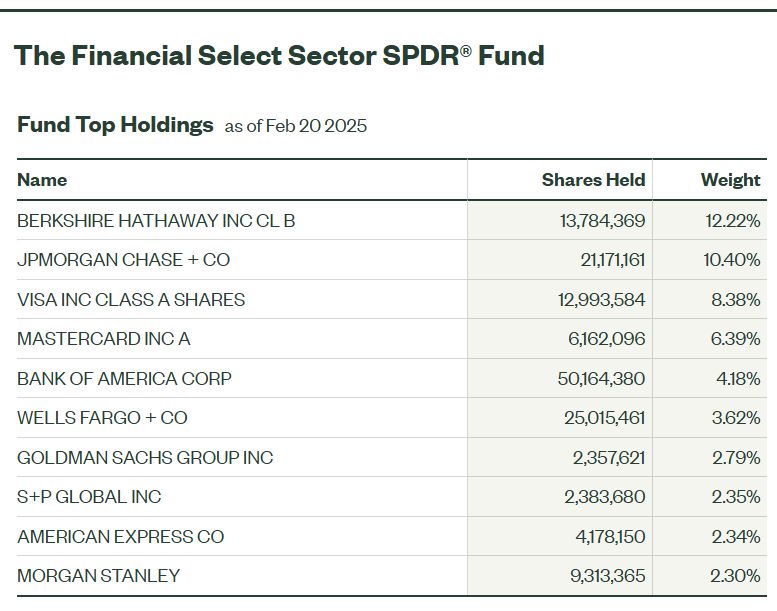
Focus: The Financial Select Sector SPDR Fund includes banks, insurance companies, investment firms, and diversified financials like Berkshire Hathaway (BRK.B).
Key Characteristics: With nearly $54 billion in AUM, XLF’s top holdings—Berkshire Hathaway, JPMorgan Chase (JPM), and Visa (V)—make up over 30% of the portfolio. It’s sensitive to interest rates and economic cycles.
Considerations: XLF rebounded with a 28.4% gain in 2024 after a challenging 2023, reflecting resilience in a high-rate environment. It’s a cyclical play suited for those expecting economic growth, though banking crises can weigh it down.
Health Care (XLV)
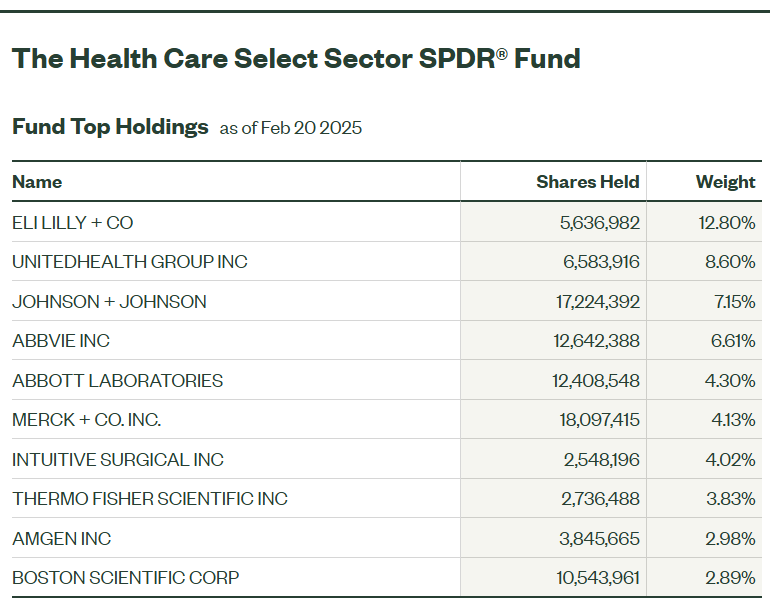
Focus: The Health Care Select Sector SPDR Fund spans pharmaceuticals, biotechnology, healthcare providers, and equipment manufacturers.
Key Characteristics: With $38 billion in AUM, XLV features stalwarts like Johnson & Johnson (JNJ), UnitedHealth Group (UNH), and Eli Lilly (LLY). Its 60+ holdings offer moderate diversification compared to tech or financials.
Considerations: Known for defensive qualities, XLV balances stability with growth from biotech innovation.
Consumer Discretionary (XLY)
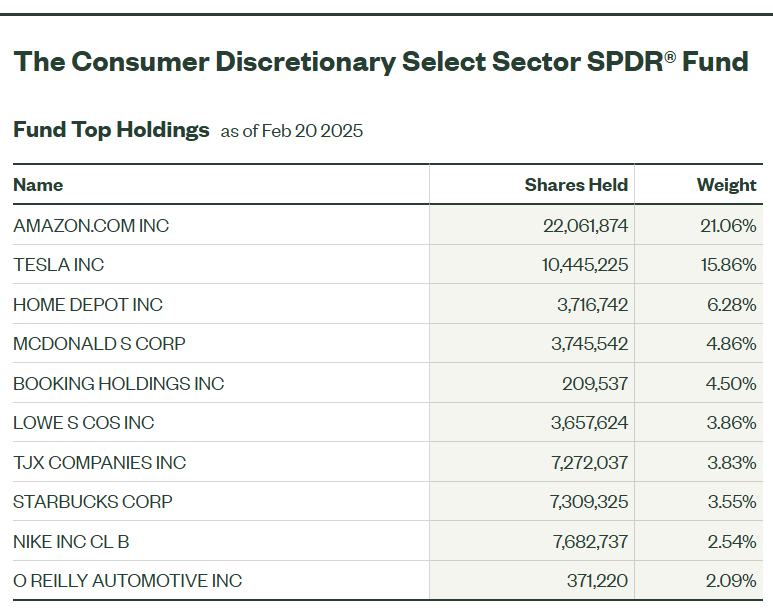
Focus: The Consumer Discretionary Select Sector SPDR Fund targets companies in retail, automotive, leisure, and media—goods and services consumers buy when confident.
Key Characteristics: With $23 billion in AUM, XLY is top-heavy with Amazon (AMZN), Tesla (TSLA), and Home Depot (HD) driving over 40% of the fund. It’s tied to economic health.
Considerations: XLY shines in strong economies but falters in recessions.
Consumer Staples (XLP)

Focus: The Consumer Staples Select Sector SPDR Fund includes essentials like food, beverages, household goods, and tobacco—products people buy regardless of the economy.
Key Characteristics: With $16 billion in AUM, XLP features Walmart (WMT), Procter & Gamble (PG), Costco (COST), and PepsiCo (PEP). It’s less volatile than discretionary peers.
Considerations: XLP is a defensive haven, offering stability in downturns but lagging in growth phases. It’s perfect for conservative investors seeking steady dividends and lower volatility.
Industrials (XLI)
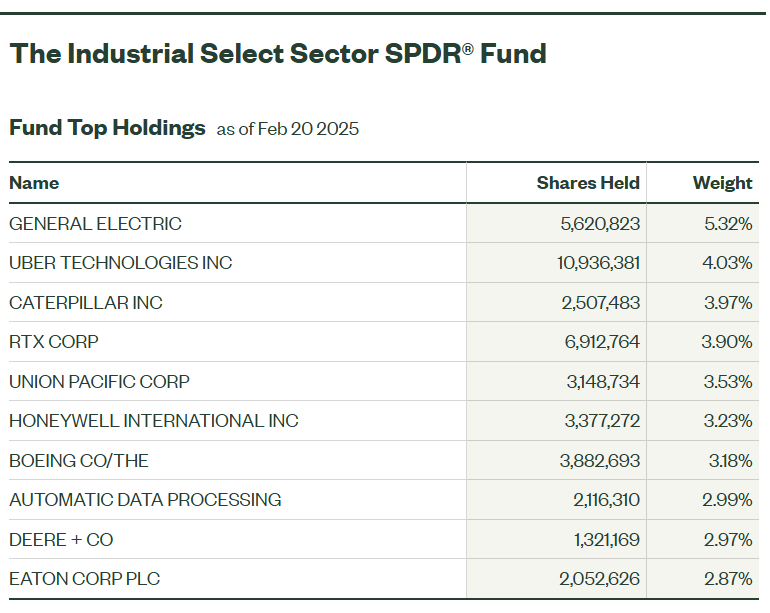
Focus: The Industrials Select Sector SPDR Fund covers aerospace, defense, machinery, logistics, and construction firms.
Key Characteristics: With $22 billion in AUM, XLI’s 78 holdings include General Electric (GE), Uber Technologies (UBER), and Caterpillar (CAT), with the top 10 at 36% of assets—relatively diversified.
Considerations: It’s a balanced cyclical play for investors eyeing industrial strength.
Energy (XLE)

Focus: The Energy Select Sector SPDR Fund focuses on oil, gas, and related equipment/services, heavily weighted toward fossil fuels.
Key Characteristics: With $33.8 billion in AUM, XLE’s 22 holdings are led by ExxonMobil (XOM), Chevron (CVX), and ConocoPhillips (COP), comprising over 40% of the fund.
Considerations: XLE swings with oil prices and geopolitics. It offers higher dividend yields but faces long-term pressure from renewable energy shifts—best for short-term or commodity-focused strategies.
Utilities (XLU)

Focus: The Utilities Select Sector SPDR Fund includes electric, gas, and water utilities—essential services with regulated revenue streams.
Key Characteristics: With $18 billion in AUM, XLU’s top holdings—NextEra Energy (NEE), Constellation Energy (CEG), Southern Co. (SO), and Duke Energy (DUK)—provide stability and dividends.
Considerations: XLU is a defensive sector, excelling in downturns but sensitive to rising interest rates. It’s a safe harbor for income-focused investors, though growth is limited.
Materials (XLB)
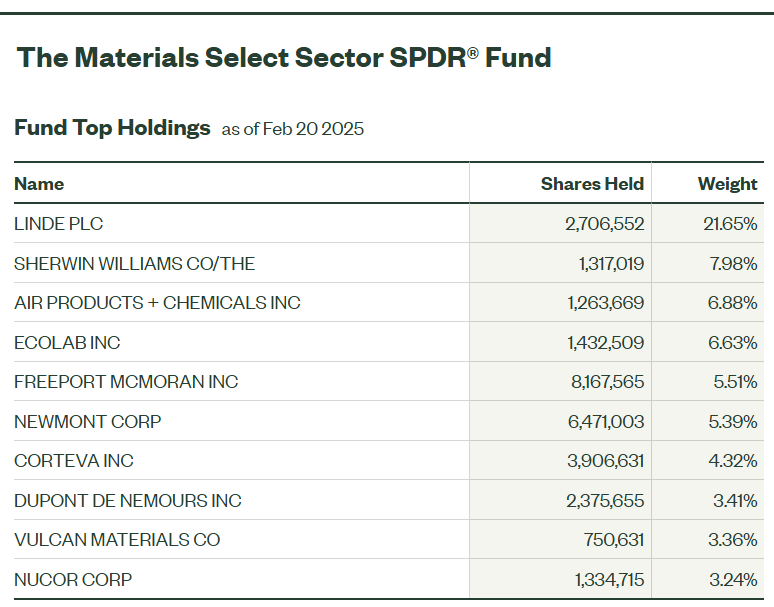
Focus: The Materials Select Sector SPDR Fund targets chemicals, metals, mining, and packaging companies.
Key Characteristics: With $5.7 billion in AUM, XLB’s 28 holdings feature Linde (LIN), Sherwin-Williams (SHW), and Air Products and Chemicals (APD). It’s tied to industrial demand and commodity cycles.
Considerations: XLB benefits from construction and manufacturing booms but lags in tech-driven markets. It’s a niche cyclical play for commodity optimists.
Real Estate (XLRE)

Focus: The Real Estate Select Sector SPDR Fund includes REITs (real estate investment trusts) in residential, commercial, and industrial properties.
Key Characteristics: With $7.3 billion in AUM, XLRE’s top holdings—Prologis (PLD), American Tower (AMT), and Equinix (EQIX)—focus on income-producing real estate.
Considerations: XLRE offers high yields but is vulnerable to rising rates and economic slowdowns. It’s a hybrid of income and growth, suited for real estate enthusiasts.
Communication Services (XLC)
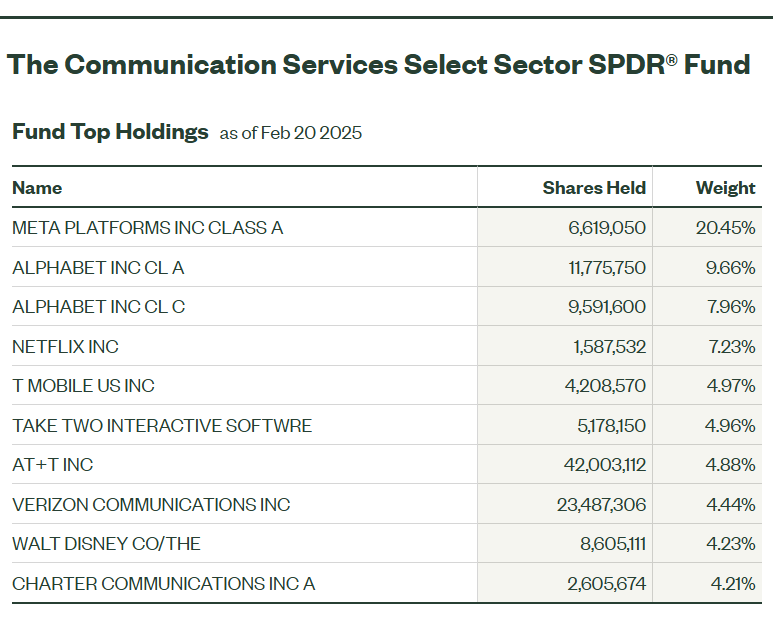
Focus: The Communication Services Select Sector SPDR Fund spans telecom, media, and internet companies, blending old and new economy players.
Key Characteristics: With $22.4 billion in AUM, XLC is dominated by Alphabet (GOOGL/GOOG), Meta (META), and Netflix (NFLX), with top holdings at 45% of assets.
Considerations: XLC captures digital ad growth and connectivity trends, offering a mix of growth (tech) and stability (telecom). It’s a modern sector play for tech-savvy investors.
Bull Markets (Strong Economic Growth)
In bull markets, investor confidence is high, economic growth accelerates, and risk-on assets thrive. Sectors tied to discretionary spending, innovation, and cyclical growth tend to outperform.
- Technology Select Sector SPDR Fund (XLK) – Tech thrives on innovation and capital investment, excelling in growth phases. Companies like Apple, Microsoft, and NVIDIA drive gains in AI, cloud computing, and consumer tech. Traits: High growth, volatile, benefits from risk appetite.
- Consumer Discretionary Select Sector SPDR Fund (XLY) – Discretionary spending rises with consumer confidence, boosting retail (Amazon), autos (Tesla), and home improvement (Home Depot). Traits: Cyclical, tied to economic optimism.
- Financial Select Sector SPDR Fund (XLF) – Banks and financial firms like JPMorgan and Berkshire Hathaway profit from higher lending activity and rising interest rates in a strong economy. Traits: Cyclical, sensitive to economic health.
- Industrials Select Sector SPDR Fund (XLI) – Infrastructure spending and manufacturing ramp up during growth, benefiting companies like Union Pacific and Caterpillar. Traits: Cyclical, linked to industrial output.
Bear Markets (Economic Downturns or Declines)
In bear markets, risk aversion dominates, and investors seek safety. Defensive sectors with stable demand and lower volatility typically perform better.
- Consumer Staples Select Sector SPDR Fund (XLP) – Essentials like food (PepsiCo), household goods (Procter & Gamble), and retail (Costco) remain in demand regardless of economic conditions. Traits: Defensive, low volatility, steady dividends.
- Health Care Select Sector SPDR Fund (XLV) – Healthcare spending persists through downturns, supporting firms like Johnson & Johnson and UnitedHealth Group. Traits: Defensive, resilient, moderate growth.
- Utilities Select Sector SPDR Fund (XLU) – Regulated utilities (NextEra Energy, Duke Energy) provide consistent revenue and dividends, making them a safe haven. Traits: Defensive, income-focused, low beta.
Recessions (Severe Economic Contraction)
Recessions amplify the need for safety, with a focus on sectors that resist discretionary spending cuts and maintain cash flows.
- Consumer Staples (XLP) – Non-negotiable demand for staples ensures stability. Traits: Recession-resistant, reliable performer.
- Health Care (XLV) – Medical needs don’t vanish, offering a buffer against economic woes. Traits: Steady, less cyclical.
- Utilities (XLU) – Essential services maintain revenue, and high yields attract income seekers. Traits: Safe, predictable.
Inflationary Periods (Rising Prices)
During inflation, sectors with pricing power or commodity exposure can outperform as costs rise and erode purchasing power.
- Energy Select Sector SPDR Fund (XLE) – Rising oil and gas prices boost profitability for ExxonMobil and Chevron, as energy costs drive inflation. Traits: Commodity-driven, volatile, high dividends.
- Materials Select Sector SPDR Fund (XLB) – Chemicals (Linde), metals (Freeport-McMoRan), and packaging firms benefit from higher commodity prices and industrial demand. Traits: Cyclical, inflation-sensitive.
- Financials (XLF) – Banks often see wider net interest margins as rates rise to combat inflation. Traits: Cyclical, rate-dependent.
Rising Interest Rates
When interest rates climb, sectors that benefit from higher yields or are less sensitive to borrowing costs tend to fare better, while rate-sensitive sectors lag.
- Financials (XLF) – Higher rates may improve bank profitability via increased lending spreads. Provided that non-performing loans are well managed. Traits: Rate-positive, cyclical.
- Energy (XLE) – Less reliant on borrowing, and commodity price spikes often accompany rate hikes. Traits: Inflation-hedge, resilient.
Mixed or Transitioning Markets
Some sectors shine in unique conditions or offer a blend of traits, making them versatile for uncertain or transitioning markets.
- Health Care (XLV) – Balances defensive qualities with growth from biotech/pharma innovation, adaptable across cycles. Traits: Versatile, steady performer.
- Industrials (XLI) – Benefits from infrastructure spending in recovery phases, offering a bridge between recession and growth. Traits: Cyclical but stable.
- Utilities (XLU) and staples (XLP) might outperform here, as stability in revenue may offer a more defensive outlook
Summary Table of ETFs by Market Condition
| Market Condition | Suitable ETFs | Key Traits |
| Bull Market | XLK, XLY, XLF, XLI | Growth, cyclical, risk-on |
| Bear Market | XLP, XLV, XLU | Defensive, stable, low risk |
| Recession | XLP, XLV, XLU | Essential demand, resilience |
| Inflation | XLE, XLB, XLF | Pricing power, commodity-tied |
| Rising Interest Rates | XLF, XLE | Rate beneficiaries, less debt-sensitive |
| Mixed/Transitioning | XLU, XLV, XLI | Hybrid, adaptable |
| Ticker | Name | 2025 YTD (as of 22 Feb 2025) | Weekly return | Monthly return | 2024 Return | 2023 Return | 2022 Return | 2021 Return | 2020 Return |
|---|---|---|---|---|---|---|---|---|---|
| SPY | SPDR S&P 500 ETF Trust | 2.36% | -1.60% | -1.07% | 23.30% | 24.29% | -19.48% | 27.04% | 16.16% |
| XLC | Communication Services Select Sector SPDR Fund | 6.41% | -2.17% | 3.80% | 33.24% | 51.41% | -38.22% | 15.12% | 25.83% |
| XLK | Technology Select Sector SPDR Fund | 1.01% | -2.13% | -2.70% | 20.80% | 54.68% | -28.43% | 33.73% | 41.83% |
| XLV | Health Care Select Sector SPDR Fund | 6.44% | 1.13% | 2.99% | 0.87% | 0.39% | -3.58% | 24.20% | 11.37% |
| XLF | Financial Select Sector SPDR Fund | 5.01% | -2.03% | 0.67% | 28.54% | 9.94% | -12.42% | 32.46% | -4.22% |
| XLP | Consumer Staples Select Sector SPDR Fund | 4.54% | 1.95% | 6.42% | 9.14% | -3.38% | -3.32% | 14.32% | 7.10% |
| XLI | Industrial Select Sector SPDR Fund | 2.34% | -1.97% | -3.86% | 15.59% | 16.07% | -7.18% | 19.49% | 8.69% |
| XLE | Energy Select Sector SPDR Fund | 6.15% | 0.95% | -0.93% | 2.17% | -4.15% | 57.60% | 46.44% | -36.88% |
| XLY | Consumer Discretionary Select Sector SPDR Fund | -2.66% | -3.79% | -5.06% | 25.47% | 38.44% | -36.82% | 27.16% | 28.19% |
| XLB | Materials Select Sector SPDR Fund | 4.67% | -1.98% | -0.76% | -1.64% | 10.12% | -14.27% | 25.17% | 17.86% |
| XLU | Utilities Select Sector SPDR Fund | 6.05% | 1.48% | 2.49% | 19.52% | -10.17% | -1.51% | 14.16% | 2.08% |
| XLRE | Real Estate Select Sector SPDR Fund | 3.84% | 0.40% | 2.75% | 1.52% | 8.48% | -28.72% | 41.71% | -5.46% |
Final Thoughts
The SPDR sectoral ETFs provide a versatile toolkit for investors. The suitability of each SPDR ETF depends on your investment goals, risk tolerance, and market outlook. Their low fees, high liquidity, and alignment with the S&P 500 make them standout options, though concentration risk (e.g., XLK’s tech giants) and sector-specific volatility require careful strategy.
Growth-focused investors might lean toward XLK and XLC, while defensive players favor XLP and XLU. XLE and XLB offer potential inflation hedges, while XLV provides flexibility across conditions. Cyclical sectors like XLY hinge on economic conditions, while XLF may shines in rate-hike cycles,
Niche areas like XLB and XLRE cater to specific bets.
Pairing these ETFs with economic forecasts can optimize returns, but their cap-weighted nature means concentration risk should always be monitored. These tools empower tactical sector rotation, a proven strategy for navigating shifting markets. Do also consult your financial advisor if these are suitable for you based on your personal risk profile.
